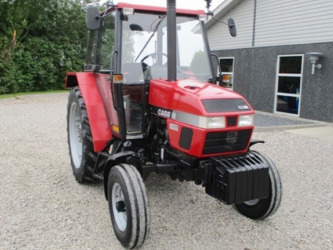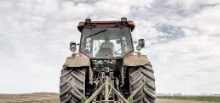________________________________________________________________________________________
| Home / Farm Tractors / Case IH Tractors / Case IH 3220 |
Case IH 3220 Troubleshooting
 The
Case IH 3220 is a 2WD or 4WD utility tractor from 3200 utility series. This
model was manufactured from 1994 to 1997. The components of Case IH 3220
powerline system: a 179 cubic inches (2.9 L) Case D179 three-cylinder
liquid-cooled diesel engine with a rated power of 50 hp (37.3 kW), and
synchromesh transmission with 8 forward and 4 reverse gears or shuttle
transmission with 8 forward and 8 reverse gears.
The
Case IH 3220 is a 2WD or 4WD utility tractor from 3200 utility series. This
model was manufactured from 1994 to 1997. The components of Case IH 3220
powerline system: a 179 cubic inches (2.9 L) Case D179 three-cylinder
liquid-cooled diesel engine with a rated power of 50 hp (37.3 kW), and
synchromesh transmission with 8 forward and 4 reverse gears or shuttle
transmission with 8 forward and 8 reverse gears.
The maximum travel speed (forward/reverse): 15.7 mph (25.2 km/h) and 5.2 mph (8.3 km/h). The open center hydraulic system includes a gear pump with rated fluid flow of 15.6 gal/min (59 l/min). The hydraulic pressure is 172 bar (2500 psi). The Case IH 3220 is equipped with a hydrostatic power steering, hydraulic wet disc brakes, 7.50-16 (2WD) or 11.2 R24 (4WD) front tyres, and 16.9-28 (2WD) or 23.1x34 (4WD) rear tyres. The wheelbase is 79.8" (2020 mm) for two-wheel drive models and 83.2" (2110 mm) for four-wheel drive models.
| Diesel Engine Troubleshooting |
| Engine starts hard or doesn't start |
Air in the fuel system - Air bleeding.
Fuel filter element is clogged - Clean the filter element.
Defective injection nozzle - Service or change injection nozzles.
Water in the fuel system - Change fuel and repair fuel system.
The valve clearance is not adjusted - Check and adjust.
Fuel injection pump damage - Change or repair the pump.
| Engine starts but then stops |
Air filter is dirty - Change air filter element.
Fuel filter element is dirty - Change the filter element.
Problems with fuel injection pump tightness - Inspect fuel injection pump for leaks.
Damaged or clogged injectors - Inspect fuel injectors and change as required.
Defective fuel injection pump - Install a new pump or rebuild.
| Engine stops unexpectedly during operation |
Engine is cold - Warm up engine as required.
Dirty fuel filter - Filter maintenance required.
Air in the fuel system - Air bleeding.
Defective or clogged injection nozzle - Change fuel injection nozzles.
Improper setting of fuel injection pump timing - Check the fuel injection pump timing adjustment.
| Engine stops while idling |
Low idle speed setting is not correct - Correct low idle settings.
Fuel injection pump is defective - Change pump or rebuild it.
Fuel injector fault - Change or clean fuel injectors.
Incorrect valve clearance - Adjust valve clearance.
| Loss of engine power |
Air filter clogged - Air filter maintenance required.
Clogged injection nozzle - Clean or replace injection nozzles.
Incorrect fuel injection pressure - Repair or replace injection pump.
The valve clearance is not adjusted - Have it adjusted.
Wrong adjustment of low idle speed - Normalize low idle speed.
Fuel lines or hoses are dirty - Clean fuel system hoses and lines.
Cylinder head gasket is blown - Change cylinder head gasket.
Defective or worn piston rings - Replace the piston rings as required.
| Engine overheats |
Insufficient coolant fluid - Add coolant fluid and inspect the cooling system for leaks.
Not enough engine oil - Fill up the engine oil.
Dirty radiator fins or faulty radiator cap - Clean radiator or replace cap.
Fan belt slipping or worn - If necessary, replace the belt.
Engine overloaded - Reduce load on the engine.
| Oil pressure is low |
Oil level is low - Fill crankcase to proper oil level.
Dirty oil filter - Clean or replace engine oil filter element.
Different type of engine oil - Use correct viscosity oil.
Incorrect oil clearance in crankshaft bearing - Bearing needs to be changed.
Worn oil pump - Repair or change.
| Engine knocking sound or abnormal noise |
Low engine oil level - Check oil level and add oil as required.
Coolant temperature is low - Warm up engine as required.
Timing of fuel injection pump is incorrect - Check the fuel injection pump timing adjustment.
Improperly adjusted low idle speed - Adjust low idle speed.
Fuel injectors are dirty or defective - Change or clean fuel injectors.
Connecting rod is misaligned or defective - Alignment procedure or replacement is required.
Pistons are scored or worn - Pistons replacement required.
| Transmission Troubleshooting |
| Transmission oil pressure is low |
Low fluid level - Add fluid to the transmission housing.
Clogged transmission fluid filter (if equipped) - Clean or change transmission fluid filter.
Relief valve is damaged - Change relief valve.
| Transmission noises |
Lack of transmission oil supply - Fill the transmission housing to proper oil level.
Transmission oil contamination - Transmission oil change required.
Backlash is incorrect or gears are damaged - Replace gears or adjust backlash correctly.
Worn or damaged bearings - Replace the bearings.
Shift forks are bent or worn out - Shift forks need to be changed.
Shaft splines are stuck or worn out - Change defective shaft.
| Gear shift is hard |
Stuck or worn gear shift linkage - Install a new gear shift linkage.
Shift forks are bent or worn out - Shift forks need to be changed.
Worn out parts of the gearshift mechanism - Replace worn parts.
Unadjusted or worn clutch - Adjust or install new clutch.
| External fluid leaks |
Transmission fluid level is exceeded - Excess fluid must be drained.
Seals or gaskets are worn - Gaskets or seal need to be replaced.
| Hydraulic System Troubleshooting |
| Hydraulic fluid pressure too low |
Insufficient hydraulic fluid - Fill up the hydraulic fluid.
Clogged hydraulic fluid filter element - Clean or change hydraulic filter.
Damaged hydraulic pump - Change or repair hydraulic oil pump.
Incorrect adjusted hydraulic spool valve - Adjust the spool valve correctly.
Hydraulic cylinder is broken - Install a new hydraulic cylinder or repair it.
Leaking hydraulic lines - Check the hydraulic system and fix leaks.
| Hydraulic system is too hot |
Main relief valve failure - Install a new relief valve.
Improper hydraulic fluid type - Use the proper type of hydraulic fluid.
Dirty hydraulic oil - The oil must be changed.
Air in hydraulic system - Bleed air from hydraulic system.
| 3-point hitch fails to lift or lifts slowly |
Heavy load on the hitch - Reduce loading.
Hydraulic oil level low - Check and refill the hydraulic oil.
Clogged hydraulic fluid filter element - Install a new hydraulic filter element.
Faulty hydraulic pump - Install a new hydraulic oil pump.
Faulty main relief valve - Install a new relief valve.
Hydraulic spool valve block is faulty - Repair or change the valve.
Hydraulic cylinder malfunction - Repair or replace hydraulic cylinder.
Disconnected or broken suction pipe - Connect or change pipe.
| Hitch cannot be dropped or dropping is too slow |
Hydraulic spool valve block is not adjusted properly - The spool valve should be properly adjusted.
Defective hydraulic cylinder - Repair or install a new hydraulic cylinder.
Unadjusted hitch - The hitch must be adjusted.
Damaged lift arm shaft - Install a new shaft.
| Jerky lifting or lowering of three-point hitch |
Air in the hydraulic system - Air bleeding.
Contaminated hydraulic fluid - Change hydraulic fluid.
Hydraulic pump failure - Install a new hydraulic oil pump.
Damaged hydraulic control valve - Change or repair hydraulic valve.
Hydraulic cylinder is faulty - Repair or change hydraulic cylinder.
| Steering Troubleshooting |
| Steering wheel is very heavy to turn |
Worn or incorrectly fitted steering column - Replace the steering column or refit it correctly.
Air in the hydraulic steering system - Air-bleed steering system.
Incorrect toe-in - Check and adjust toe-in.
Uneven wear on front tyres - Replace the tyres.
Damaged hydraulic steering pump - Replace or repair steering pump.
Steering pump control valve is worn or stuck - Clean or install new control valve.
Steering fluid level is insufficient - Add oil to steering system.
| Excessive free play of steering wheel |
Worn steering column coupling or shaft - Change defective part.
Steering pump failure - Install a new steering pump.
Loose or worn steering linkage parts - Inspect and replace as required.
| Tractor pulls to left or right |
Uneven wear on front tires - Replace the tires.
Incorrect toe-in - Check and adjust toe-in.
Loose or worn steering linkage parts - Check and replace as required.
Worn or incorrectly adjusted or worn front wheel bearings - Adjust correctly or replace bearings.
| Electrical Troubleshooting |
| Battery is not charging |
Wiring connections are loose or corroded - Service or tighten cable connections.
Battery terminal clamps are defective - Terminal clamps should be changed.
Battery dead cell - Install a new battery.
Loose or defective belt - Belt needs to be adjusted or changed.
| Starter motor cranks slow |
Battery power is low - Battery is drained, charge it.
Battery does not hold charge - Service or replace the battery.
Battery terminals are corroded or wires are disconnected - Check cable connections and change or clean terminals.
| Starter is not working |
Battery is drained or worn - Change or recharge battery.
Battery cables are disconnected or incorrectly connected - Check cables and connect as needed.
Low battery voltage - Charge the battery.
Starter motor is faulty - Starter should be changed.
________________________________________________________________________________________
________________________________________________________________________________________
| Farm Tractors Technical Specifications |
